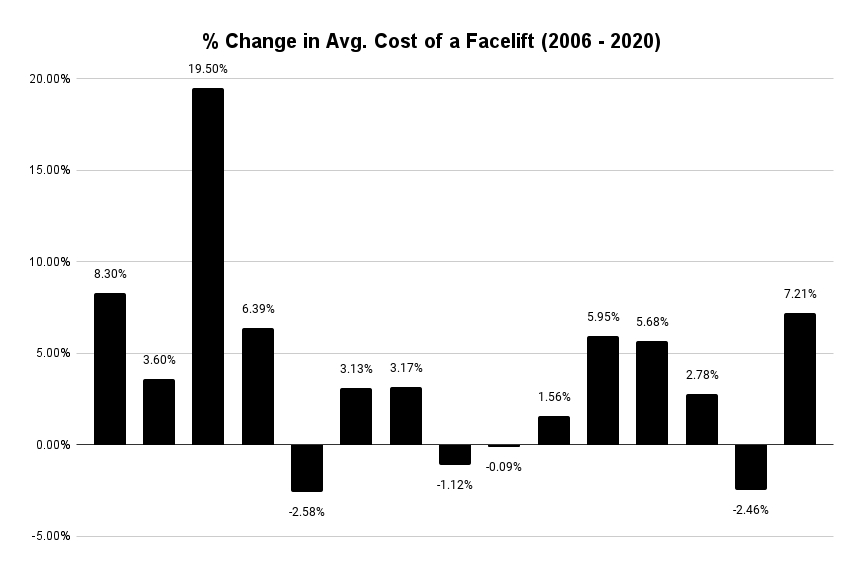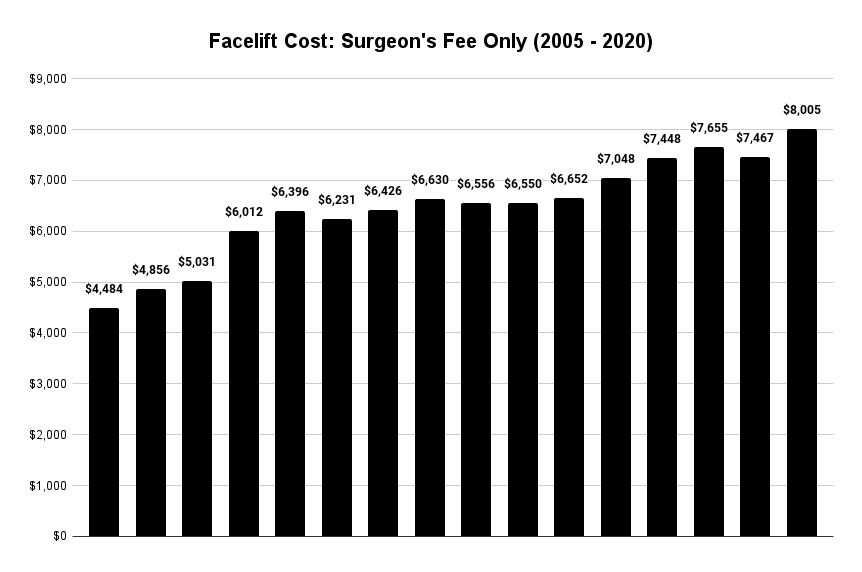What a year it’s been for plastic surgery. Elective procedures were postponed. Patients waited and prices soared.
Facial plastic surgeries occupied 60 percent of Top 5 positions and for the first time in 15 years, breast augmentation was not the nation’s most popular plastic surgery procedure.
Where does that leave the cost of a facelift as of 2021?
According to the American Society of Plastic Surgeons, the average fee that plastic surgeons around the U.S. charged for the popular procedure rose by 7.2 percent, making the facelift the most expensive it ever has been.

But those figures reflect only the performing physician’s fee and are not all-inclusive. In actuality, an $8,000 facelift is probably best avoided altogether, but at the very least, should be approached with extreme caution.
This article covers everything you need to know about the cost of a facelift, including national U.S. average costs, how to finance a facelift, whether facelifts are covered by health insurance, and what red flags to look out for in finding an affordable facelift.
Unfortunately, facelifts are expensive.
To avoid the high price of a facelift, you might be tempted to pursue discount surgery or to finance a facelift with high-interest credit cards or loans. Neither of these is a smart idea.
Facelift Cost By Year
The average surgeon’s fee for a facelift in the United States in 2020 was $8,005.
Plastic surgery prices rose considerably during the pandemic and in 2020, the average cost of a facelift increased by 7.2 percent nationally.
- 2020: $8,005
- 2019: $7,467
- 2018: $7,655
- 2017: $7,448
- 2016: $7,048
- 2015: $6,652
- 2014: $6,550
- 2013: $6,556
- 2012: $6,630
- 2011: $6,426
- 2010: $6,231
- 2009: $6,396
- 2008: $6,012
- 2007: $5,031
- 2006: $4,856
- 2005: $4,484
All-Encompassing Cost of a Facelift
As high as the figures above may be, none of them will actually pay for a facelift. The fees above are just one part of your total out-of-pocket costs since they only represent the average surgeon’s fee for the procedure.
All costs considered, you are likely to pay between $10,000 and $20,000 for a facelift, with the best facial plastic surgeons charge almost that much in physician’s fees alone.
Are Facelifts Covered By Insurance?
Because facelifts are elective cosmetic surgeries and are not necessary to resolve a health condition, illness, or disease, they are not covered by health insurance.
Complications caused by a facelift are also unlikely to be covered by health insurance.
What Fees Are Included in the Cost of a Facelift?
The sum total cost of a facelift is comprised of a number of smaller fees that include:
- Lab work and medical tests from your primary physician in order to determine your suitability for the procedure.
- Your plastic surgeon’s or physician’s fee
- The costs of operating room use at a hospital, or the fees associated with an on-site or accredited ambulatory surgical facility
- The cost of anesthesia
- Prescription medications, such as for pain relief.
Should You Choose a Facial Plastic Surgeon Based on Their Prices?
The cost of a facelift is only one of many factors involved in choosing a facial plastic surgeon. But it should never be the only thing you base your decision upon.
Some plastic surgeons set their prices higher than average because their skills and experience are (much) higher than average.
Others set their price higher because they falsely feel that their results, reputation, or experience warrant it. Some set slightly higher prices to give the illusion of superior quality.
Discount plastic surgery is bad plastic surgery. But so is its opposite.
If Price Is a Determining Factor
If while doing your homework and due diligence, you decide that you like two or more surgeons about equally and price alone ends up being a deciding factor, instinct alone would likely tell you that the most expensive surgeon is the better surgeon.
But that is not always the case. The safest way to your potential surgeon’s skill level, experience, and quality of results is to view their facelift gallery.
How To Read a Plastic Surgeon’s Facelift Gallery
- Look online. If the surgeon does not host a gallery of before and afters on their website, that is a red flag not worth passing by.
- Assume the gallery displays (only) the surgeon’s very best work.
- Look for PLENTY of photographs for the procedure you intend to have. There should be TONS of them and they should be recent. (Gallery results are rarely dated but old photographs are often easily detectable by their poor quality and lighting, and they may even appear to be scanned in from print photographs, making them clearly outdated.)
- If you don’t “get sick of” browsing a surgeon’s gallery, they likely have too few results on display.
- When you are satisfied that the surgeon does in fact perform facelifts frequently, scan the gallery for patients whose “before” photos look like you—perhaps a similar face shape, hairstyle, or facial features and “defects” similar to those you hope to have corrected.
Inspect these particular before-and-after photographs more carefully in order to identify what exactly you appreciate about them. Do you like the transformation that took place? Is it natural-looking? Subtle? Does the person’s face look stretched, or windblown? Do all of the “after” photos look very similar? (They should not).
The facelift surgery should have been adapted to their unique facial features, rather than applying a one-style-fits-all approach that leaves all patients looking somewhat similar. You can check their rhinoplasty (nose job) gallery where any cookie-cutter approach would be instantly visible. - Print out, or screenshot and save the before-and-after photos that you like and be prepared to tell your surgeon what you like about them exactly.
- Search YouTube for “facelift [surgeon’s name],” which will possibly give you the opportunity to see more than a still photograph from someone who has a facelift by your surgeon of choice.
Getting a Great Plastic Surgeon at a Good Price
You’ve done your due diligence and settled on your favorite facial plastic surgeon. How do you get the best possible price?
Plastic surgery practices are not flea markets or swap meets. Bargaining is out of the question. Or is it?
1. Does the Practice Offer “Packages”
Service or treatment packages and specials are unlikely to actually reduce your out-of-pocket expenses for a facelift. They will, however, give you more bang for your buck. Some practices will provide deeply discounted or even free non-surgical treatments to patients who are undergoing major surgical procedures. Unlike discounted plastic surgery procedures—which you should never pursue—discounted non-surgical treatments or injectables are worth considering.
2. Are You a Veteran?
Many practices offer reduced fees for active-duty members of the armed forces and for veterans. If you fit that bill, ask about discounts for service personnel.
3. Are You a Teacher or Educator?
Discounts for teachers and faculty are less common than are discounts for military members and veterans, but some practices do offer them.
4. Do You Work For a Charity, Non-Profit, or NGO?
For patients who devote great amounts of time to charity, non-profit groups, and NGOs, or who make significant monetary contributions to the same, discounts may be available.
5. Did the Practice Offer You a Second (or Third) Complimentary Consultation?
This last suggestion may require some finesse and won’t work with all facial plastic surgeons, but it is worth knowing about. Because plastic surgeons and their practices are, fundamentally, businesses, they make sound business decisions. If you failed to reach back out to a surgeon’s office or actually schedule your surgery date after an initial free or paid consultation, did the Patient Coordinator or Office Manager reach back out to you?
Did they offer you a second or even third complimentary consultation? If so—and that’s not uncommon—ask yourself if you are comfortable with sharing the nitty-gritty.
If you love the surgeon’s work but the cost of service is putting you off for a year (or altogether), mention it if you’re comfortable doing so. You might just be responded to privately with a reduced fee.
[Please note that this is very different than a surgeon whose gaudy advertisement campaigns focus on cheaper-than-average prices and deep discounts.]

